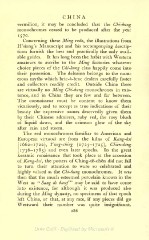Page 352 - Oriental Series Japan and China, Brinkly
P. 352
CHINA
vermilion, it may be concluded that the Chi-hung
monochromes ceased to be produced after the year
1570.
Concerning these Ming reds, the illustrations from
H'siang's Manuscript and his accompanying descrip-
tions furnish the best and practically the only avail-
able guides. It has long been the habit with Western
amateurs to ascribe to the Ming factories whatever
choice pieces of the Chi-hung class happily come into
their possession. The delusion belongs to the num-
erous myths which bric-a-brac dealers carefully foster
and collectors readily credit. Outside China there
are virtually no Ming Chi-hung monochrones in exis-
tence, and in China they are few and far between.
The connoisseur must be content to know them
vicariously, and to accept as true indications of their
beauty the expressive names deservedly given them
by their Chinese admirers, ruby red, the rosy blush
of liquid dawn, and the crimson glow of the sky
after rain and storm.
The red monochromes familiar to American and
European virtuosi are from the kilns of Kang-hsi
(16621722), Tung-ching (17231725), Chien-lung
(17361785) and even later epochs. In the great
keramic renaissance that took place at the accession
of Kang-hsi, the potters of Ching-te-chen did not fail
to turn their attention to ware so celebrated and
highly valued as the Chi-hung monochromes. It was
then that the much esteemed porcelain known in the
West as " Sang de bceuf" may be said to have come
into existence, for although it was produced also
during the Ming dynasty, no specimens of that epoch
left China, or that, at any rate, if any pieces did go
Westward their number was quite insignificant.
286

